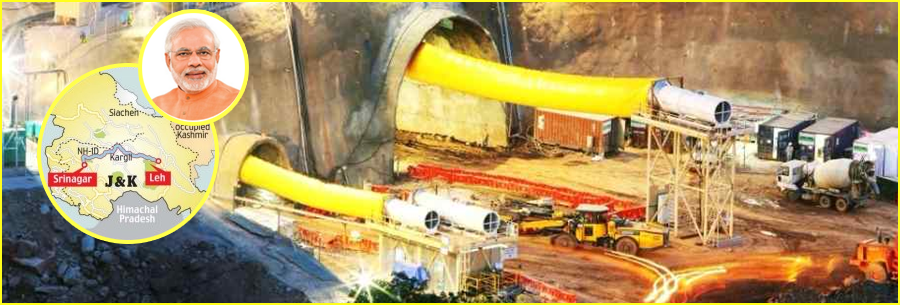New life for Kashmir valley - PM flags off work for Zojila Tunnel

The valley of Kashmir is all set to get a new life with the upcoming new project ‘Zojila Tunnel’ which aims at providing connectivity between Srinagar, Kargil and Leh. Prime Minister Narendra Modi has unveiled the plaque to mark the commencement of work for Asia’s longest bi-directional road tunnel.
The 14.2 km long Zojila Tunnel will be India’s longest road tunnel and Asia’s longest bi-directional tunnel and will have immense strategic importance. Situated at an altitude of 11,578 ft on Srinagar-Kargil-Leh National Highway the Zojila pass remains shut during winters due to heavy snowfall and avalanches.
On 3 January 2018, the Cabinet Committee on Economic Affairs (CCEA), chaired by the Prime Minister Narendra Modi, gave its approval for construction of the road tunnel. The project which aims to provide a new step of development for Ladakh, involves construction, operation and maintenance of two-lane bi-directional Zojila Tunnel with Parallel Escape (Egress) Tunnel excluding approaches on Srinagar-Leh section connecting NH-1A at 95.00 km and at 118.00 km in Jammu and Kashmir on engineering, procurement and construction (EPC) mode.
This project alongwith other ongoing projects like 6.5 km long Z-Morh tunnel at Gagangir will ensure safe, fast and cheap connectivity between the two regions of Kashmir and Ladakh.
The project had been in the tendering stage for the over last four and half years. The first tender for the project was floated way back on 26 November 2012. A re-tendering was done on 20 May 2013 due to tepid response it received in November 2012. After shortlisting four contractors, Ministry of Road Transport and Highways (MoRTH) cancelled the tender and re-invited bids for the third time on 1 August 2015.
Following this, the tunnelling work was awarded to IRB Infrastructure, the sole bidder in January 2016. However, on 1 March 2016, MoRTH terminated the contract awarded to IRB Infrastructure.
Within 15 days, fresh bids were invited from the contractor to undertake the project valued at Rs 9,090 crore on BOT (Annuity) basis. However, poor response once again forced the MoRTH to cancel the tendering process and re-issue it through National Highways & Infrastructure Development Corporation (NHIDCL) on 6 January 2017, on EPC basis. Following this, the tender value was reduced to Rs 5,950 crore. But the ill fate continued and the original tender floated on 6 January 2017 got extended four times.
Finally, on 19 January 2018, IL&FS Transportation Networks bagged the contract for construction, operation and maintenance of the project on EPC basis at a cost of Rs 4,899.42 crore with construction period fixed at 2,555 days.
SMEC bagged a contract for preparation of detailed project report (DPR) and providing pre-construction activities for construction of approach roads with avalanche protection works to west and east portal of Zojila Tunnel (between Baltal and Minamarg) from 82.00 km to 95.00 km on Srinagar-Leh road (NH-1) and making NH-1 from Z-Morh tunnel to proposed Zojila Tunnel (approx 20 km) all weather road.
The total capital cost of the project is Rs 6,808.69 crore. This includes the cost towards land acquisition, resettlement and rehabilitation and other pre-construction activities as well as maintenance and operation cost of tunnel for four years.
The project will take seven years to complete. Once the Zojila Tunnel, an all-weather connectivity project in India is completed it will reduce travel time from 3.5 hours to mere 15 minutes, and will provide accessibility for transportation, trade, health, education and tourism.
The tunnel has been planned as a smart tunnel. It will have latest safety features like fully transverse ventilation system, uninterrupted power supply (UPS), tunnel emergency lighting, CCTV monitoring, variable message signs (VMS), traffic logging equipment, over height vehicle detection, etc. It will also have pedestrian cross passages at every 250 mtr and motorable cross passages and lay-bys at every 750 mtr. Apart from this, it will have emergency telephones and fire-fighting cabinets at every 125 mtr.